Buying alternative combine headers – the options
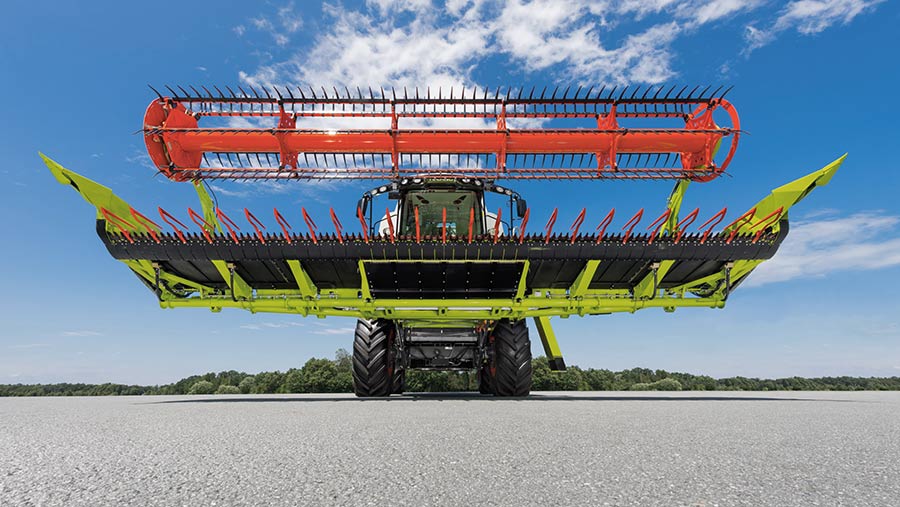 Hydro-pneumatic suspension on the Claas Convio Flex header provides 90mm of upwards and 135mm of downwards movement © Claas
Hydro-pneumatic suspension on the Claas Convio Flex header provides 90mm of upwards and 135mm of downwards movement © Claas Buying a new combine rarely involved much discussion about header options when there was no choice other than to decide what width to hook on the front.
But that has changed with the advent of increasingly more sophisticated designs that have different features and enable operators to fine-tune their front-end setup for various crops and ground conditions.
Knife position fore-aft adjustment came first, providing a changeable relationship between cutterbar, reel and auger to suit particular crop situations.
See also: Top tips to keep your combine running in the wet
And now, with bigger, more powerful combines packing huge performance potential from advanced threshing, separation and cleaning systems, there’s a greater need for speed and efficient crop-gathering from ever-wider working widths.
This has brought into the mix draper belt conveying, and articulated frames and flexible cutterbars to cope with contours and irregular field surfaces.
As a consequence, combine manufacturers are making available header designs previously confined to the big, open fields of Australia, Canada, the US and parts of eastern Europe, while independent header specialists are piling into the UK market with new initiatives for this year’s harvest campaign.
Honey Bee and MacDon from Canada and the US, respectively, along with Biso from Austria and Geringhoff from Germany, are setting out their stall in the UK this year.
MacDon is launching a new version of its draper model claiming 20% more capacity, 30% faster working speed and 70% more flex.
OEM and independent manufacturers alike hope to cash in on burgeoning demand for headers that leave an even stubble across wide widths and permit fast working speeds in challenging – as well as easy-going – conditions.
Metric to imperial measurement
Just as with wheel and tyre rim sizes, imperial measurements still hold sway when it comes to quoting the width of a combine table, so here’s a quick reference conversion.
Combine header conversions |
|||||||
|
5.48m |
6.1m |
7.62m |
9.15m |
10.67m |
12.5m |
13.7m |
15.2m |
|
18ft |
20ft |
25ft |
30ft |
35ft |
40ft |
45ft |
50ft |
Auger headers with belt feed
This long-established table design pioneered on Massey Ferguson combines has an extended but fixed position for the knife, with multiple belts then providing crop feed across the bed to the centre-delivery auger.
This arrangement is said to make it especially effective for harvesting oilseed rape, as the reel can be set higher to minimise pod shatter and the belts gather shed seed that may otherwise slide back over the knife.
Good performance in laid crops is also reported, with the belt installation tending to deflect any stones picked up.
Agco Power Flow
Widths: 5.5m, 6.2m, 6.8m, 7.7m, 9.2m, 10.7m, 12.2m
Wide belts convey crop across the 1.14m gap between the fixed knife and the gathering auger on the Power Flow Fendt or Massey Ferguson-branded tables.
An optional rapeseed kit comprises vertical side knives and a top auger that helps gather and convey large volumes of crop vegetation.
The 9.2m and wider models have a 710mm-diameter Superflow main auger in place of the 610mm version fitted to smaller sizes for extra conveying capacity.
The Autodoc and Agtag option provides a single in-cab button press to connect the header drive, hydraulics and electrics.
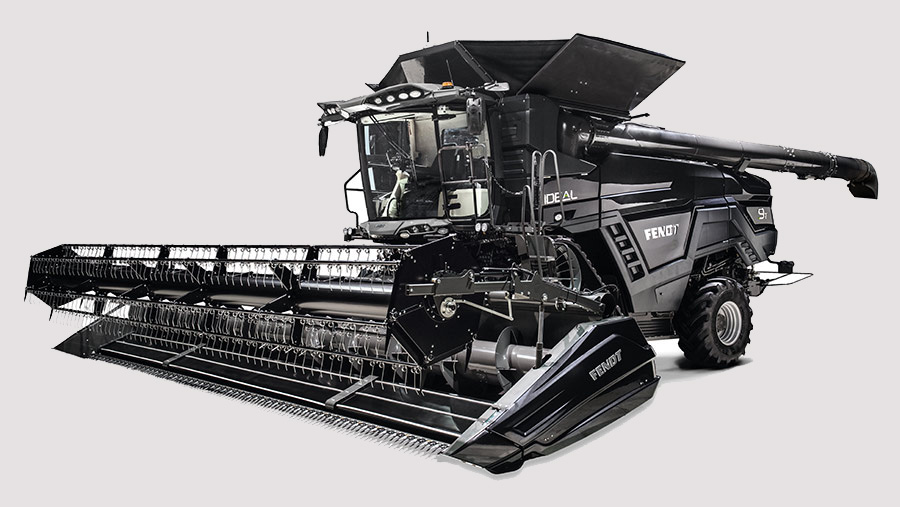
Agco’s Power Flow header for Fendt and MF combines has belt bridging the forward-mounted knife and the crop conveying auger © Agco
John Deere 600PF/700PF
Widths: 5.15m, 6.1m, 6.7m, 7.6m, 9.15m, 10.7m, 12.2m
The Premium Flow headers built for John Deere by Zurn Harvesting position the rigid knife 1m ahead of the auger with a series of equal-width bed belts providing a positive feed.
In addition to fitting clip-on vertical side knives, operators can raise the 660mm- or 760mm-diameter gathering auger using a hand-operated hydraulic pump to make more room for large volumes of crop material.
Sealed to keep out soil and stones, each self-tensioning belt assembly lifts up for access and dust can be removed from drawers when changing between rapeseed and grain or at the end of harvest.
A single-lever coupling connects hydraulic and electric supplies.
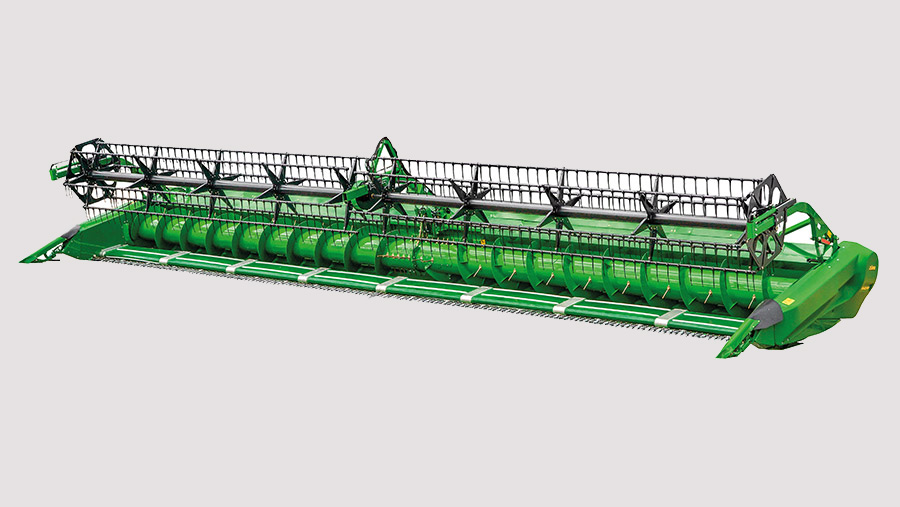
John Deere 600PF/700PF belt-feed auger headers are built by Zürn with the cutterbar positioned 1m ahead of the auger © John Deere
Auger headers with flexible cutterbar
A flexible cutterbar allows the knives to cut close to the ground while also adapting to surface contours.
This capability enables the cutterbar to ride over embedded stones to some extent, but is especially useful for maintaining a short, even stubble length across very wide headers, and for harvesting laid and low-growing crops.
Individual cutterbar support arms have either hydraulic cylinder or air bag suspension, with adjustable pressure enabling the operator to adapt the table to different crops and conditions.
Adjustments are made either on the header or inside the cab, with the maximum pressure setting effectively making the cutterbar rigid.
Biso VX Crop Ranger Trendline Light Flex
Widths: 4.5m, 5m, 5.5m, 6m, 6.5m, 7.5m, 8.5m
Biso’s headers are unique in combining cutterbar flexibility and knife-to-auger adjustment.
On this model, the cutterbar has 560mm of stepless position adjustment to alter the bed depth for different crops and conditions, while also having 150mm of vertical movement once a few retaining screws are removed from the stainless steel bed.
Biso 3D Varioflex Air/Air i
Widths: 5.7m, 6.7m, 7.7m, 9.1m, 10.7m, 12.3m,14.0m, 16.0m
On this wider, more sophisticated header, the flexible cutterbar is supported by a series of arms on the underside of the bed.
Each is formed as a parallelogram to maintain a consistent knife angle as they allow up to 170mm of vertical movement supported by air bellow suspension units.
The Varioflex Air i version has sensor skids under the cutterbar sending signals wirelessly to a 13in tablet computer that operates air valves for active control, and which enables the operator to set the ground pressure from zero to 50kg or make the bar rigid.
The touchscreen display shows real-time cutterbar movement and the system includes “intelligent” reel height control to avoid clashing with the cutterbar at very low settings when lifting laid crops.
Both versions have 800mm of stepless bed depth adjustment, which positions the knife from just 180mm to 980mm ahead of the auger flights, and integral side knives are positioned hydraulically once the grain crop dividers have been removed.
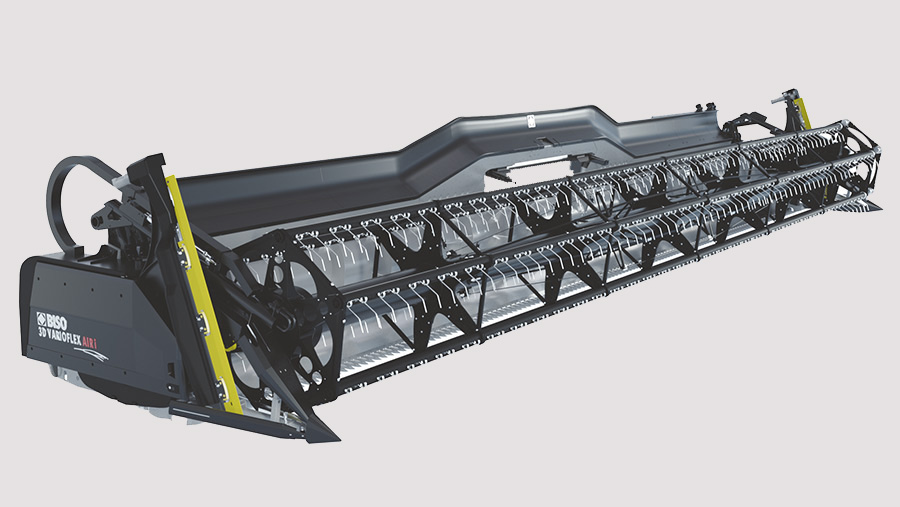
The Biso 3D Varioflex Air rigid-frame header has fore-aft adjustment of the flexible cutterbar and built-in rapeseed knives © Biso
New Holland 740CF Superflex
Widths: 6.1m, 7.62m, 9.15m, 10.6m
A cutterbar supported by arms mounted on rubber suspension elements is a feature of the 740CF Superflex header for New Holland combines, which gathers crop using a 406mm-diameter auger with retracting fingers along its entire length.
Tension in each of the rubber elements can be adjusted manually to ensure even performance across the cutterbar, which has 152mm of vertical movement, and an in-cab control option is available to stiffen the cutterbar or make it completely rigid to suit different ground and crop conditions.
All flotation adjustments can be made using the combine’s IntelliView display and CommandGrip multi-function control handle, along with variable-speed hydraulic drive to the reel.
Rigid frame draper headers with rigid cutterbar
Combine headers with large rubber belts gathering crop to the feeder house – once the preserve of harvesters working vast grain plains in Australia and North America – have come into favour in the UK as cutting widths have grown beyond the 9m mark.
The downsides of these devices include an increase in the number of moving parts and the need to occasionally use adjusters to keep belts running true.
But positive collection of material off the cutterbar, a large conveying surface area and the potential to adjust belt speed – especially on hydraulic-drive models – mean a well-set-up draper header can deliver large quantities of crop material to the feeder housing consistently and head first for efficient threshing and initial separation.
Claas Convio
Widths: 9.22m, 10.4m, 11.9m
Automatic belt speed adjustment relative to the combine’s working speed is a key feature of the Convio, especially when uneven crops result in frequent manual or automatic changes in the rate of the harvester’s progress.
The 1,079mm-wide lateral belts operate in a 1,329mm-deep trough, and can be reversed along with the central belt under full load before restarting slowly to help clear an overload.
The header’s newly developed hydraulically driven reel has automatic torque control through the drive and flip-over tines to minimise crop hang-up. Clip-on vertical knives can be added for oilseed rape.
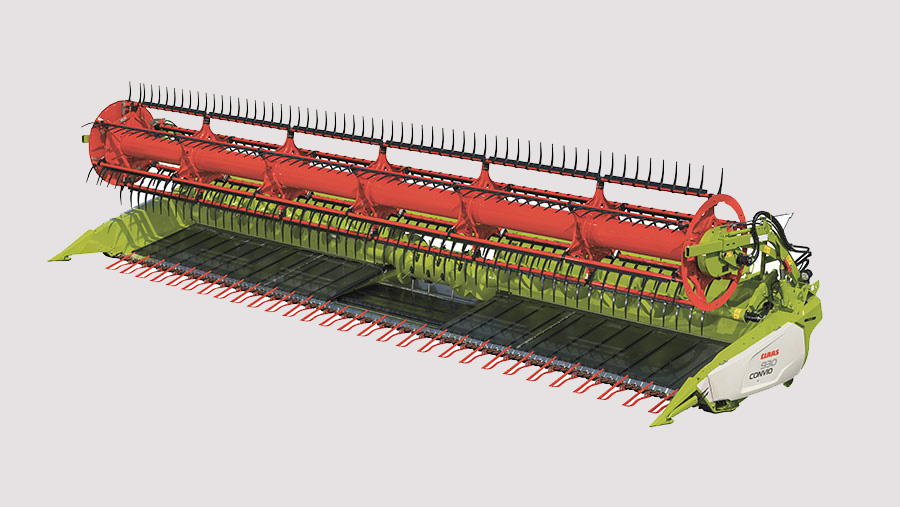
Automatic belt speed adjustment relative to the combine’s working speed is a key feature of the Convio auger-draper header © Claas
Honey Bee RDX Grain Belt
Widths: 7.62m, 9.1m, 10.9m, 12.2m, 13.7m, 15.2m
In contrast to the standard Grain Belt model, the RDX version header from Canadian manufacturer Honey Bee makes use of mechanical drives for all elements except the reel.
The cutterbar (which is Honey Bee’s design using Schumacher sections), the feed drum, 1,485mm-wide centre belt and 1,066mm-wide draper belts are all powered through a shaft and powerband driveline that can be reversed from the cab to clear plugs.
All RDX models except for the 7.62m version are a few kilos lighter than the hydraulically driven Grain Belt design and the range includes two wider sizes.
Fore and aft adjustment relies on the combine’s functions and an auger can be fitted to supplement the belts for bulky crops such as oilseed rape.
Honey Bee Grain Belt
Widths: 6.4m, 7.62m, 9.1m, 10.9m, 12.2m, 12.8m
A mechanically driven onboard hydraulic system features on this Honey Bee header, providing drive to the epicyclic cutterbar, the 1,727mm centre belt and 1,829mm feed drum, and to the 1,066mm-wide draper belts, the speed of which can be adjusted manually using a valve on the header to match the ground speed and volume of incoming crop.
The cutterbar installation is reckoned to be one of the lowest available, resulting in tight stubble lengths when required, and the header is equipped with hydraulic fore-aft adjustment and leaf springs that provide lateral and vertical suspension independently of the host combine’s system.
An auger at the top side of the angled draper belts can be fitted to help cope with bulky crops.
John Deere 700D
Widths: 7.6m, 9.15m, 10.7m, 12.2m
Although the centre belt is fixed at 240m/min on John Deere’s 700D fixed-knife draper header, hydraulic drive to the 1,016mm lateral belts can be adjusted infinitely up to 223m/min.
Also, the belts can be slowed rapidly to a pre-set speed using an in-cab Command Arm control – when not cutting to the full width or when coming out of the crop, for example – and automatic monitoring guards against belt damage from slippage on the idler rollers.
An auger of 420mm or 457mm diameter can be added to the top side of the belts, along with mechanically driven vertical side knives, for harvesting oilseed rape and similarly bulky crops.
A lateral tilt feeder housing adding 4deg of movement to the 6deg provided by the Hydrafloat pressure control system is recommended to get full benefit of the header levelling system on sloping or uneven terrain.
MacDon D1
Widths: 7.6m, 9.1m, 10.7m, 12.2m, 13.7m
A key feature of the MacDon D1 fixed-knife draper header is the FM100 Float Module, says the Canadian manufacturer.
It has two sets of coil springs to support up to 97% of the header’s weight, with a single mechanical sensor prompting “instant response” from a mechanism that provides almost 5deg of lateral float – that’s 610mm at the end of a 13.7m version – and 178mm of vertical float independent of the combine’s feeder housing.
The central feed drum with bolt-on flights and retractable fingers to suit different host combines is fed by a 2,007mm-wide belt receiving material from the two 1,067mm lateral belts, with these and the cutterbar all powered via independent hydraulic circuits.
As an option, the side draper belts can have in-cab speed control up to 194m/min and a cross auger with tighter flight pitch towards the centre that supplements the belts for bulky crops is also on the options list.
New Holland 840CD Grain Draper
Widths: 7.6m, 9.1m, 10.7m, 12.5m, 13.7m
Variable knife speed giving up to 1,260 cuts/min and adjustable lateral belt drive cater for different working speeds, crops and conditions on the New Holland 840CD fixed-knife draper header.
The 1,056mm-wide lateral belts set at 22.6deg are powered by variable-speed hydraulic drive at up to 863rpm to convey crop to the 2,108mm central belt running at 769rpm.
Up to 7deg of fore-aft tilt (4deg forward, 3deg aft) to fine-tune knife angle can be selected from inside the cab, and gauge wheels are installed on the three largest sizes.
For bulky crops, an upper auger can be fitted to complement the belts.
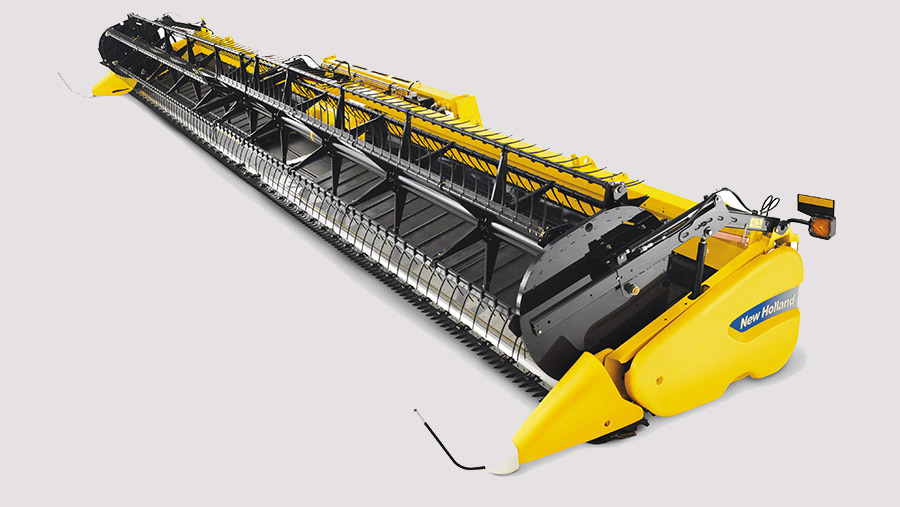
The NH 840CD has lateral belts measuring 1,056mm set at 22.6deg from horizontal © New Holland
Rigid frame draper headers with flexible cutterbar
In addition to handling large volumes of crop vegetation on their conveying belts, draper headers with a flexible cutterbar can adapt to field surface contours.
This is handy when harvesting laid or low-growing crops such as peas and herbage seed, and also for large combines that can exploit the widest working widths.
Different forms of suspension support the knife-mounting arrangement, with adjustable pressure enabling operators to set up the header for crop and ground conditions.
Case IH 3020 Flexheader
Widths: 6.1m, 7.63m, 9.15m, 10.6m
Rubber torsion blocks provide the spring element on arms supporting the flexible cutterbar on Case IH’s 3020 Flexheader.
They can be adjusted individually by hand to ensure consistent performance across the table, or collectively to suit different crops and ground conditions when the optional central hydraulic adjustment system is installed.
Up to 150mm of vertical movement is available, or the cutterbar can be made rigid when flexibility is not needed.
The trough floor for the 400mm/ 660mm conveying auger is constructed from stainless steel.
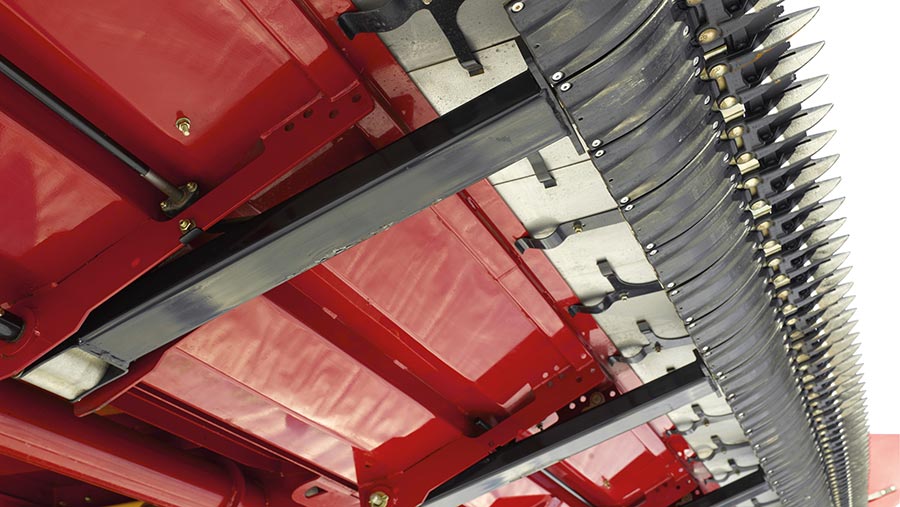
Cutterbar support arms on the Case IH 3020 Flex header have rubber torsion block suspension elements © Case IH
Claas Convio Flex
Widths: 7.70m, 9.22m, 10.7m, 12.2m, 13.8m
In addition to the feed belt set-up (see the Claas Convio fixed-knife draper table) the Convio Flex has a flexible cutterbar supported on arms with hydro-pneumatic suspension.
The suspension provides 225mm of vertical movement – 90mm upwards and 135mm downwards from the regular position – and can be operated using four modes.
“Cereal” mode makes the table and knife bar rigid, while “Laid crop” mode enables the operator to switch from rigid to flexible on the move with the press of a button to handle patches of laid crop.
In “Manual flex” mode, the knife bar suspension uses information from underbed sensors to respond to ground contours without exerting pressure, while in “Auto flex”, the system automatically determines the best position for crop flow and matching ground contours while maintaining the lowest possible cutting height.
Geringhoff Flex
Widths: 9.2m
This rigid-frame model has a Schumacher flexible knife system with centre drives running at 1,100-1,200 strokes/min.
Conveying belts 1,043mm wide with in-cab speed adjustment feed a 2,200mm-wide central belt, which also has speed adjustment (on the header) to suit different crops, and a 620mm-diameter feed-in drum with manual height adjustment.
The belts can be supplemented by vertical side knives and a 350mm-diameter auger with manual height adjustment to keep tall and bulky crops from boiling over the backplate.
Honey Bee AirFlex
Widths: 7.6m, 9.1m, 10.9m, 12.2m, 13.7m, 15.2m
Canadian manufacturer Honey Bee is focused on this design for its foray into the UK through Oria Agriculture and Agri Market Insight and Access.
The rigid-framed header’s flexible cutterbar, mechanically driven from the centre, is supported by an air bag suspension system that can be adjusted using an in-cab control box for maximum 229mm vertical flexibility when running on the poly-skids to harvest laid and low-growing crops.
Pumping up using the on-board compressor stiffens the cutterbar to suit ground and crop conditions through to rigid, to cut standing grain and oilseed crops.
For the latter, and also for tangled crops such as peas, mechanically driven side knives are available, along with a draper shield to help smooth the flow, and a hydraulic-drive cross-auger to complement the reversible mechanically driven smooth-surfaced cleated belts.
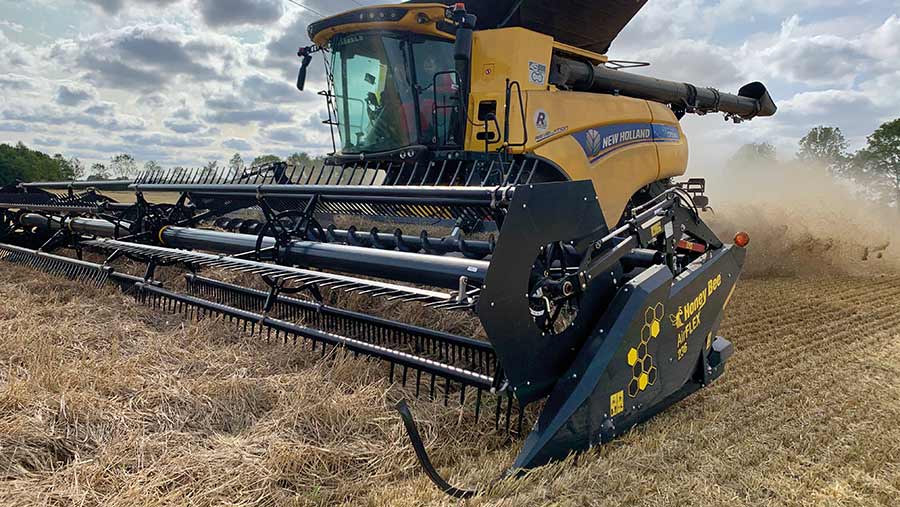
A Honey Bee AirFlex rigid-frame draper header with flexible knife working in a laid barley crop © Homey Bee
John Deere RDF HydraFlex
Widths: 9.15m, 10.7m, 12.2m, 13.7m
John Deere’s Rigid Draper Flex knife header for S-series and X-series combines sports a 414mm-diameter feed drum at its centre, with retracting tines and a choice of two operating speeds as part of its spec.
It’s fed by a dual-speed 1,776mm-wide belt – both can be reversed to clear plugs – flanked by variable-speed shaft-driven draper belts 1,016mm wide. These can be supplemented as an option by a 457mm-diameter hydraulically driven auger to handle tall and bulky crops.
All speeds are adjustable from the cab, auto mode links draper belt speed to forward speed, and reduced belt mode, selectable from the in-cab touchscreen, slows belt speed when cutting across only half of the header.
The HydraFlex cutterbar with 190mm of vertical movement is supported beneath the otherwise rigid table by a series of fabricated arms. These are tensioned by hydraulic cylinders, providing float control when operating on the ground with dial-adjustable pressure and a rigid setting for off-ground cutting.
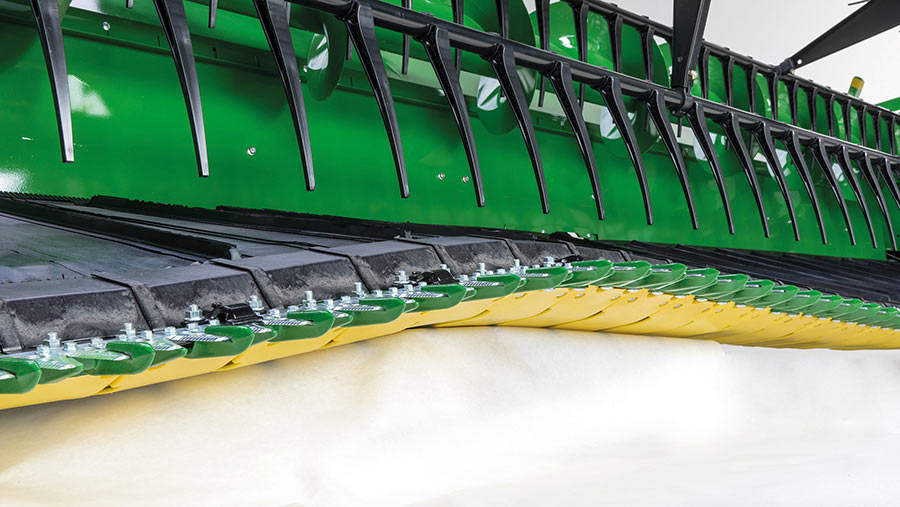
The HydraFlex cutterbar on John Deere RDF headers provides 190mm of vertical movement to match surface contours and irregularities. © John Deere
New Holland 880CF Superflex
Widths: 9.15m, 10.6m, 12.5m, 13.7m
With the 880CF header, New Holland provides a combination of draper belts and a flexible cutterbar – and the largest cutting width – for the CX walker and CR rotary combines.
The cutterbar design is the same as on the 740CF Superflex auger header as far as the flexing arrangement is concerned but with variable rather than fixed knife speed capable of up to 1,260 cuts per minute.
Crop is conveyed by 1,056mm wide draper belts set at a 22.6deg angle and converging at a 2,108mm wide feed belt and a 660mm diameter floating feed drum.
The speed of this unit is fixed at 150rpm, as is the centre belt at 769rpm. But the side belts are adjustable up to 863rpm thanks to the hydraulic drive with in-cab control and there is automatic drive delay after reversing to clear a plug.
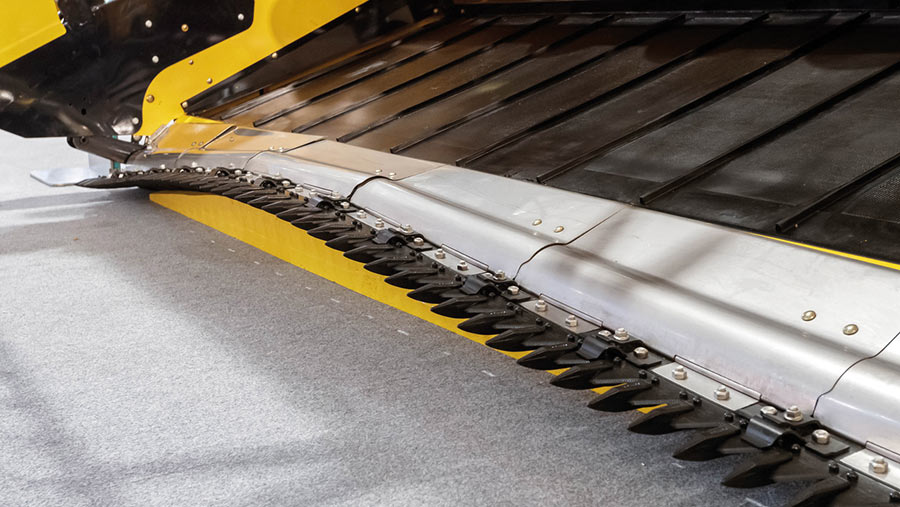
The New Holland 880CF SuperFlex draper header is available in widths up to 13.7m © New Holland
Articulated frame draper headers with rigid cutterbar
An articulated frame adds another dimension to a wide header’s ability to follow undulating contours.
Typically constructed in three sections, manufacturers make their case for the advantages or otherwise for sections of equal width or a narrower centre frame with wing sections attached.
Geringhoff TruFlex/TruFlex Air
Widths: 10.7m, 12.2m
This is the header design that Geringhoff is focused on for its first year in a sales partnership with Agco for Fendt and Massey Ferguson combines, while continuing to supply growers with other makes.
The articulated header is constructed in three sections of the same width to follow undulating ground contours, and uses a rigid Schumacher knife system.
Gathering and central belt features and specifications are the same as for the rigid-frame Flex model, but the TrueFlex headers can have Geringhoff’s Variable Integrated Air System (V-IAS), which creates a flow of air from just behind the knife that blows shed seed onto the draper belts.
In oilseed rape, trials have shown this system reducing losses by 32% when comparing a TrueFlex Razor flexible knife header operating with and without the air curtain, and by 47% compared with a rigid but fore-aft-adjustable knife auger header.
John Deere HDX
Widths: 10.7m, 12.2m, 13.7m
These headers are constructed with two wide wing sections pivoting off a narrow centre section, with the pivots aligned with the tracks on John Deere X-series combines.
The 1,200mm-wide conveying belts, driven at speeds from 72-228m/min, have a “grain saver” surface pattern with shallow cross-hatchings in addition to the usual cleats to catch shed grains and seeds.
These belts can be supplemented by a 432mm auger with retracting fingers along its length to help feed bulky crops to the central belt and to the feed drum, which can be set to one of two speeds and two heights for different crops.
Hydraulically adjusted gauge wheels can raise the header for rapeseed or retract for cutting laid and low-growing crops close to the ground.
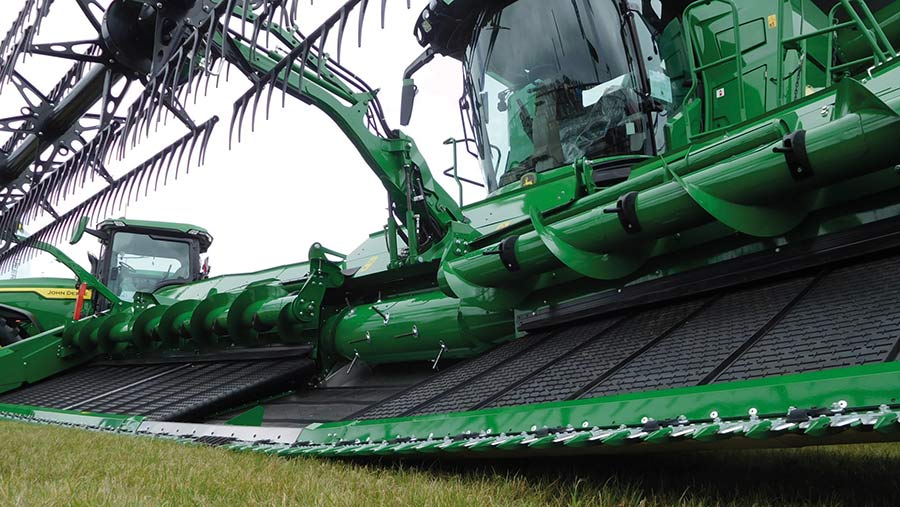
Pivot points on the John Deere HDX header frame align with the combine’s tracks to follow ground contours © John Deere
MacDon FD1 FlexDraper
Widths: 7.6m, 9.1m, 10.7m, 12.2m, 13.7m
The MacDon FlexDraper combines a slim cutterbar profile, generous lateral and vertical float separate from the feeder house, and reel characteristics that collectively are designed to allow surface-skimming performance in laid and low-growing crops.
In-cab knife angle adjustment adds to the mix, with the two-section reel providing tines spaced at 100mm and “flip-over” geometry that tucks under laid/low crops to lift them to the knife.
Twin pivots creating a narrow centre section and two longer wings enable the header to follow undulations for consistent stubble height; but the pivots can be locked out when a rigid frame is preferable.
Draper specifications and features are the same as for the D1 Draper rigid header.
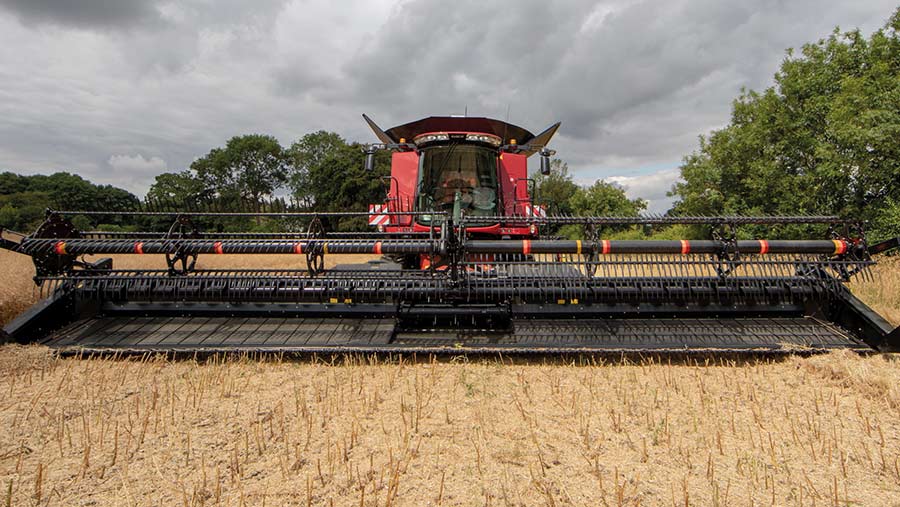
MacDon claims good surface-skimming performance in laid and low-growing crops for its FD1 Flexdraper header © MacDon
Articulated frame draper headers with flexible cutterbar
This approach combines the contour-following performance of a sectioned frame with the added ability of a flexible cutterbar to ride over surface irregularities and large stones.
Geringhoff TruFlex Razor/Razor Air
Widths: 10.7m, 12.2m
Razor versions of the TruFlex header add a flexible knife to the three-section frame to compensate for irregular field surfaces and large stones as well as rolling contours.
All features and specs are otherwise similar to those of the Flex and TruFlex models, including the optional air curtain system and the potential to reduce losses when cutting OSR crops.
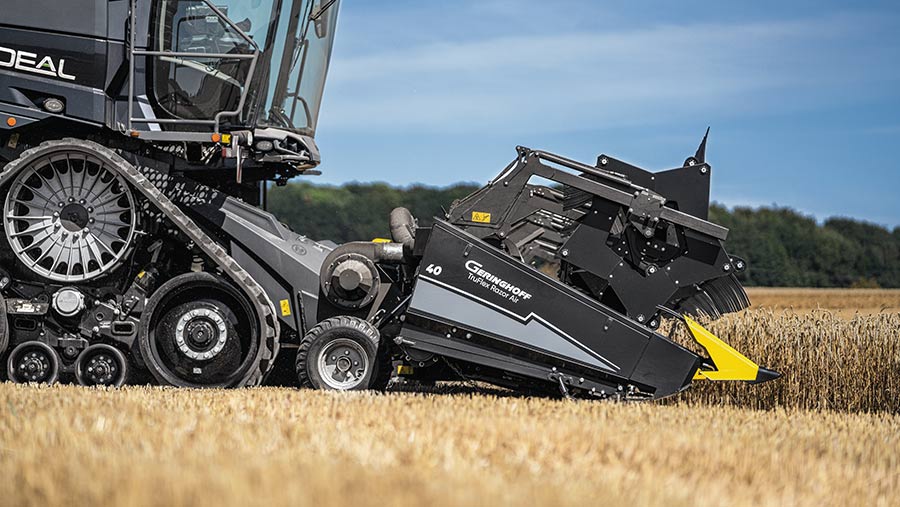
The Geringhoff TruFlex Razor combines an articulated header frame with a flexible cutterbar © Geringhoff
Crop stripping headers
The technique of stripping grains from stems that remain anchored in the soil promotes increased harvesting output by significantly reducing the volume of straw going into the combine.
An ability to “hoover up” laid cereals and herbage seed crops is also claimed, while leaving a tall “stubble” and minimal chopped straw on the surface are cited as further advantages, especially for direct-drilling of following crops.
And although a stripping header will harvest difficult-to-cut crops such as linseed, it will not work in oilseed and other non-grain species.
Shelbourne Reynolds Stripper RSD/CVS/XCV
Widths: RSD 6.1m, 7.3m. CVS 4.80m, 6m, 7.63m, 8.83m, 9.6m. XCV 9.63m, 10.8m, 12.6m
The Stripper headers use a variable-speed comb rotor to remove grains and seeds, with the reduction in straw and other matter passing into the combine said to lift throughput by 30-50%.
The lack of a cutterbar makes the RSD model (designed primarily for rice) suited to harvesting ryegrass, which is often badly laid and wet, while the all-purpose CVS and XCV tackle cereal and linseed crops.
The widest three sizes of the CVS version are offset to balance the heavier drive end, but all XCV models are centrally mounted on a pivoting adapter frame which, along with sprung outrigger wheels, enables the header to adapt to ground contours.
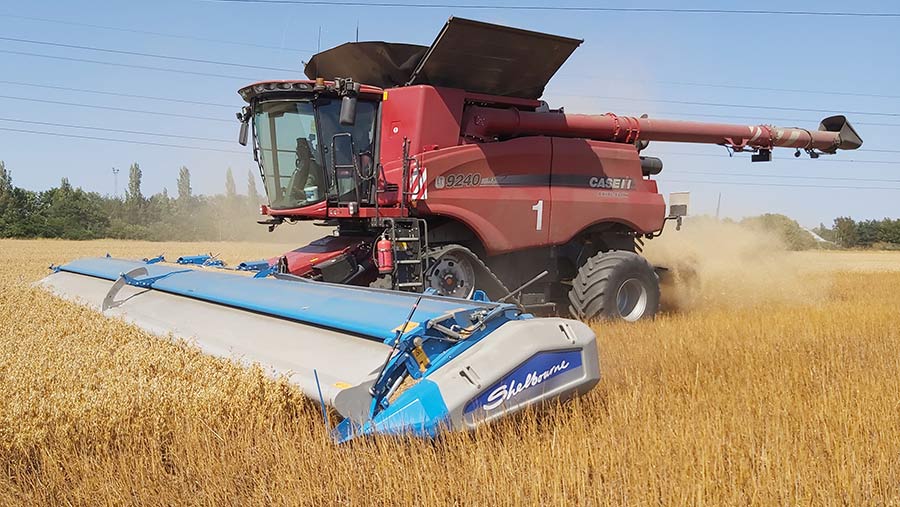
The Shelbourne Reynolds Stripper – this is the XCV42 – tackles grain and linseed by stripping to leave straw firmly anchored © Shelbourne Reynolds
